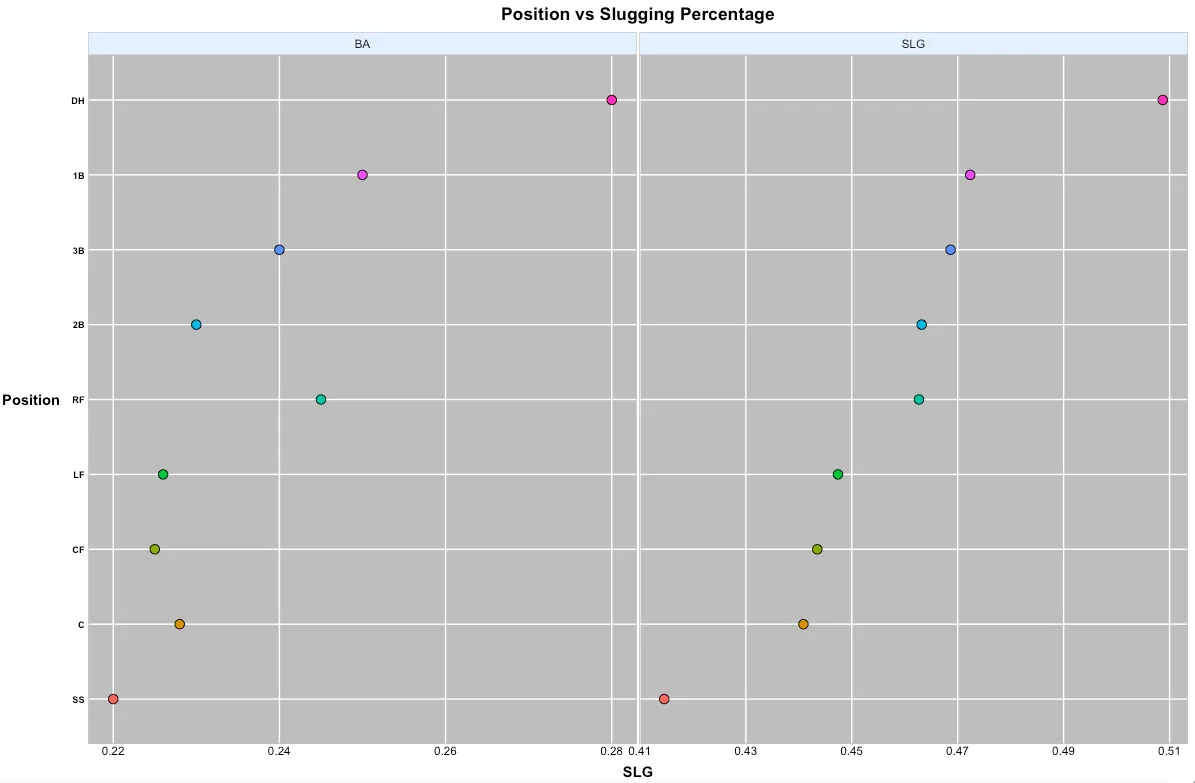我想改变BA、SLG的外观顺序,变成SLG、BA。我发现有类似的问题,但是我的解决方案可能行不通,因为我已经在Excel中汇总了数据。因此,我的数据框架可能不同。无论如何,我尝试实施这个方法都没有成功:
df2 <- factor(df, levels = c("SLG","BA"))
df <- read.table(textConnection(
'POS SLG BA
2B 0.4632 .23
3B 0.468652174 .24
SS 0.4146 .22
1B 0.472368421 .25
RF 0.462684211 .245
CF 0.4435 .225
LF 0.4474 .226
C 0.440875 .228
DH 0.508714286 .28'), header = TRUE,stringsAsFactors = FALSE)
library(micromapST)
library(ggplot2)
library(tidyr)
library(dplyr)
df$POS <- reorder(as.factor(df$POS), df$SLG)
dfx <- gather(df, group, data, SLG, BA)
row.names(df) <- NULL
theme_set(theme_grey() +
theme(plot.title = element_text(hjust=0.5,face='bold'),
axis.title.y = element_text(angle = 0, vjust = 0.5,face='bold'),
axis.title.x=element_text(face='bold'),
panel.background = element_rect(fill = "gray"),
axis.ticks=element_blank()))
plot <- ggplot(dfx, aes(x = data, y = POS, group = group, fill = POS))+
labs(title = "Position vs Slugging Percentage", x = "SLG", y = "Position") +
geom_point(shape = 21, size = 3) +
theme(plot.title = element_text(hjust = 0.5),
plot.subtitle = element_text(hjust = 0.5),
plot.caption = element_text(hjust = -0.5),
legend.position = "",
strip.text.y = element_blank(),
strip.background = element_rect(fill = rgb(.9,.95,1),
colour = gray(.5), size=.2),
panel.border = element_rect(fill = FALSE, colour=gray(.75)),
panel.grid.minor.x = element_blank(),
panel.grid.minor.y = element_blank(),
panel.spacing.x = unit(0.07,"cm"),
panel.spacing.y = unit(0.07,"cm"),
axis.ticks = element_blank(),
axis.text = element_text(colour = "black"),
axis.text.y = element_text(size = rel(.78), face = "bold",
margin = margin(0,0,0,3)),
axis.text.x = element_text(margin = margin(-1,0,3,0))) +
facet_grid(~group, scale = "free")
plot

dfx <- gather(df, group, data, SLG, BA)之后,执行dfx$group = factor(dfx$group, levels=c("SLG","BA"))。 - eipi10group。 - eipi10